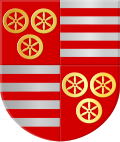Doorn | |
|---|---|
 Gate house to Huis Doorn | |
| Coordinates: 52°02′N5°21′E / 52.033°N 5.350°E | |
| Country | Netherlands |
| Province | Utrecht |
| Municipality | Utrechtse Heuvelrug |
| Area | |
• Total | 22.27 km2 (8.60 sq mi) |
| Elevation | 5 m (16 ft) |
| Population (2021) [3] | |
• Total | 10,260 |
| • Density | 460/km2 (1,200/sq mi) |
| Time zone | UTC+1 (CET) |
| • Summer (DST) | UTC+2 (CEST) |
| Postal code | 3941 [1] |
| Dialing code | 0343 |
Doorn is a town in the municipality of Utrechtse Heuvelrug in the central Netherlands, in the province of Utrecht. The town is famous for being the final residence of Wilhelm II. [4]







